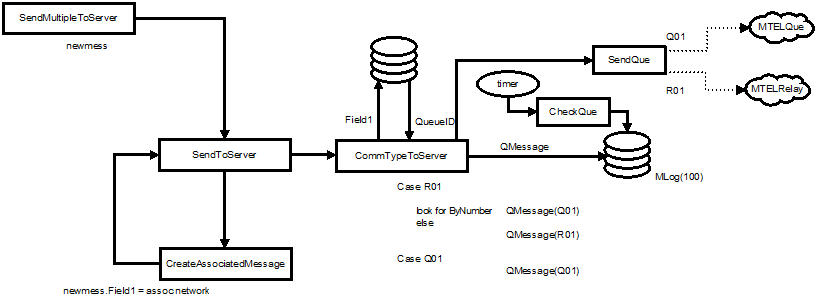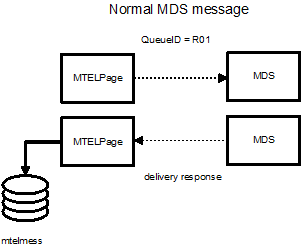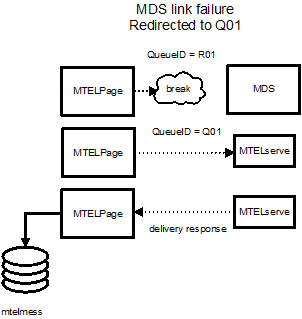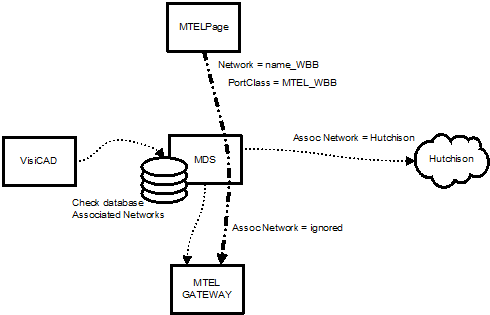MTELPage allocates a
network to a pager in the configuration file "picocell pstn data.mdb". The pager destined for a WBB picocell has a network of
picocellname_WBB and it has a queue route indication of R01. This means the first
attempt to deliver the message is via the MDS system.
Messages are created in MTELPage and inserted into a
rotating queue of 100 records. During the insert process the message packets are
sent by TCP to MTELQue (local servers) or MTELRelay (MDS servers). The messages
stay in the MTELPage queue and are indexed by the message ID. Responses back
from the MTELRelay or MTELQue are referenced by the message ID and the records
are updated, removed or rerouted.
If MTELPage detects there are associated networks to the
picocellname_WBB, adhoc groups or normal groups then these additional messages
are also generated and sent to the queue.
ByNumber routing
There is one special case of routing. If the MTELPage
ByNumber function is used, the message is most likely not in any of
the MDS or MTELPage databases and it is therefore always routed to Q01.
This eliminates the generation of alarms in the MDS system to indicate a
number is not in the database.

Normal Operation
When a message is
allocated to a WBB network it is first routed to the MDS over the WAN via
MTELRelay.
If the MDS is capable
of accepting the message, it will be delivered by a direct link to MTEL. The
MDS will return the result of the message delivery back to MTELPage via
MTELRelay. MTELPage stores the response in the history file mtelmess.mdb.

In the MDS
configuration the picocellnetwork_WBB has a PortClass of
MTEL_WBB. This directs the message to OPC dedicated to a direct link to
the MTEL WBBGateway.

MDS Internal Failure
If the MDS detects that
the OPC direct link to MTEL has failed it will look for a fallback path.
The MDS will look in the network table and find the
backup network of MTEL_WBB_DIALUP with a PortClass of PSTN. This is a PSTN dial up service to
MTEL. If this service fails to deliver the message then the message fails
altogether and provides a failure indication back to MTELPage. It can use
any of the standard PSTN OPCs.

MDS Link Failure
If the MDS is not
operational or the link to the MDS is not functioning the MTELRelay sends
the message back to MTELPage. MTELPage then re-routes it to the local
MTELQue by changing the QueueID to Q01 and reassigning the
message in the queue. The reassignment is done immediately and a TCP packet
is sent to the MTELQue on the receipt of the failed packet from the relay.
The logs maintain the
information that the message was originally sent to the MDS and that it has
been redirected.

The MTELQue now looks up the local definition for
the picocellname_WBB network in the picocell pstn data.mdb
file and it is defined as a dialup PSTN service to a
MTEL PET dial up service dedicated to WBB services. This is also a backup to the
MTEL Direct system operating through the MDS.

MTELPage allocates a
network to a pager. The pager destined for a WBB picocell has a network of
picocellname_WBB.
Normal Operation
The MTELQue now looks up the local definition for
the picocellname_WBB network and it is defined as a dialup PSTN
service to a MTEL dial up service dedicated to WBB services (MTEL
PETGateway). This is also a
backup to the MTEL Direct system operating through the MDS.
Original Operation
The WBB networks have a name of
picocellname_WBB it is defined as a dialup PSTN
service to a Vodaphone (Hutchison) dial up service. The messages are then
transmitted by Hutchison through their terrestrial and satellite networks.
The messages are decoded and filtered across a database on the MTEL Gateway.
This system will remain as an alternative if the MTEL
PETGateway fails. It will also continue to provide a gradual conversion
between the two systems as the Comms centres move to the direct systems. In
addition to this requirement VisiCAD is often used as a primary turnout
instead of MTELPage so the MDS must be capable of operating from both
sources simultaneously.
VisiCAD to MDS Operation
While MTELPage is the primary source for picocell
operation, some centres are using VisiCAD as a primary source. VisiCAD
generated messages use the pager id to look up the network and related
associated networks.
As part of the move from Hutchison based picocell
messages to MTELGateway based messages the associated networks table must be
changed to include a Hutchison associated network
in the list. Many picocells are close to Hutchison coverage and so form part
of the intended message network coverage.
In summary VisiCAD generated messages use the
associated networks table and create additional messages as required,
MTELPage generated messages only go to one network which is included in the
message packet from MTELPage.

MTELPage 2014 roll-out will be phased in over several
weeks.
The MTEL Dialup services will be available from the 1st
April.
The WBB DIRECT will be available from the 1st May.
The operation described above comes into full operation
from the 1st of May for Comms Centres upgraded to MTELPage 2014.

